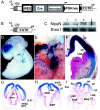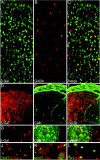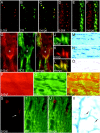Cortical excitatory neurons and glia, but not GABAergic neurons, are produced in the Emx1-expressing lineage
- PMID: 12151506
- PMCID: PMC6758181
- DOI: 10.1523/JNEUROSCI.22-15-06309.2002
Cortical excitatory neurons and glia, but not GABAergic neurons, are produced in the Emx1-expressing lineage
Abstract
By homologous recombination of an internal ribosome entry site and Cre recombinase coding region into the 3'-untranslated region of the mouse Emx1 gene, we have generated a strain of mice, Emx1(IRES)cre, that expresses the Cre recombinase in a spatial and temporal pattern like that observed for Emx1. When mated to reporter strains, these mice are a sensitive means to fate-map the Emx1-expressing cells of the developing forebrain. Our results demonstrate that radial glia, Cajal-Retzius cells, glutamatergic neurons, astrocytes, and oligodendrocytes of most pallial structures originate from an Emx1-expressing lineage. On the other hand, most of the pallial GABAergic neurons arise outside the Emx1-expressing lineage. Structures that are located near the basal ganglia (e.g., the amygdala and endopiriform nuclei) are not uniformly derived from Emx1-expressing cells.
Figures




References
-
- Birling MC, Price J. A study of the potential of the embryonic rat telencephalon to generate oligodendrocytes. Dev Biol. 1998;193:100–113. - PubMed
-
- Briata P, Di Blas E, Gulisano M, Mallamaci A, Iannone R, Boncinelli E, Corte G. EMX1 homeoprotein is expressed in cell nuclei of the developing cerebral cortex and in the axons of the olfactory sensory neurons. Mech Dev. 1996;57:169–180. - PubMed
-
- Chai Y, Jiang X, Ito Y, Bringas P, Jr, Han J, Rowitch DH, Soriano P, McMahon AP, Sucov HM. Fate of the mammalian cranial neural crest during tooth and mandibular morphogenesis. Development. 2000;127:1671–1679. - PubMed
-
- Chan CH, Godinho LN, Thomaidou D, Tan SS, Gulisano M, Parnavelas JG. Emx1 is a marker for pyramidal neurons of the cerebral cortex. Cereb Cortex. 2001;11:1191–1198. - PubMed
-
- Chanas-Sacre G, Rogister B, Moonen G, Leprince P. Radial glia phenotype: origin, regulation, and transdifferentiation. J Neurosci Res. 2000;61:357–363. - PubMed
Publication types
MeSH terms
Substances
Grants and funding
LinkOut - more resources
Full Text Sources
Other Literature Sources
Molecular Biology Databases
Research Materials
